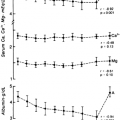PARATHYROID HORMONE-RELATED PROTEIN
Gordon J. Strewler
Parathyroid hormone–related protein (PTHrP), sometimes referred to as parathyroid hormone–like protein, is the sister of PTH. Originally identified as the cause of humoral hypercalcemia in malignancy, PTHrP has a distinct set of physiologic functions that are unrelated to the regulation of systemic calcium homeostasis but rival the actions of PTH in their importance.
It has been recognized since Fuller Albright’s time that in some ways patients with malignant tumors causing hypercalcemia resemble patients with primary hyperparathyroidism (pHPT). Malignancy-associated hypercalcemia is characterized not only by humorally mediated bone resorption but also by diminished tubule resorption of phosphate with consequent phosphaturia and hypophosphatemia. When it was recognized that the disorder also produced an increase in nephrogenous cyclic adenosine monophosphate (cAMP), which is the component of urinary cAMP secreted into the urine from the renal tubule,1 it became clear that a humoral factor in patients with malignancy-associated hypercalcemia was mimicking PTH at the kidney. Increased nephrogenous cAMP was previously thought to be unique to hyperparathyroidism, reflecting increased secretion of cAMP from the renal tubule, where cAMP is the intracellular second messenger for PTH. Once it was understood that increased cAMP concentrations in kidney or bone cells could be used as a bioassay to detect the humoral factor secreted by malignant tumors, the substance responsible for malignancy-associated hypercalcemia was purified and shown to be a protein that was structurally related to PTH.2,3 and 4
Stay updated, free articles. Join our Telegram channel

Full access? Get Clinical Tree





